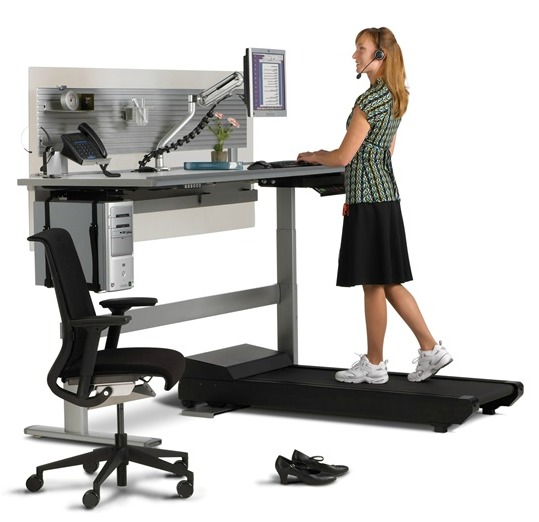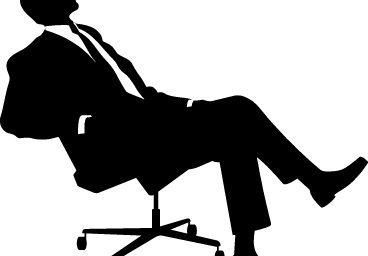Standing While Working
While periodic, strenuous exercise is better than nothing, constant movement is much better for our health.
While periodic, strenuous exercise is better than nothing, constant movement is much better for our health.
The Economist (“Standing orders–Real science lies behind the fad for standing up at work“):
WINSTON CHURCHILL knew it. Ernest Hemingway knew it. Leonardo da Vinci knew it. Every trendy office from Silicon Valley to Scandinavia now knows it too: there is virtue in working standing up. And not merely standing. The trendiest offices of all have treadmill desks, which encourage people to walk while working. It sounds like a fad. But it does have a basis in science.
[…]
Health ministries have been nagging people for decades to do more exercise. What is surprising is that prolonged periods of inactivity are bad regardless of how much time you also spend on officially approved high-impact stuff like jogging or pounding treadmills in the gym. What you need instead, the latest research suggests, is constant low-level activity. This can be so low-level that you might not think of it as activity at all. Even just standing up counts, for it invokes muscles that sitting does not.
Researchers in this field trace the history of the idea that standing up is good for you back to 1953, when a study published in the Lancet found that bus conductors, who spend their days standing, had a risk of heart attack half that of bus drivers, who spend their shifts on their backsides. But as the health benefits of exercise and vigorous physical activity began to become clear in the 1970s, says David Dunstan, a researcher at the Baker IDI Heart & Diabetes Institute in Melbourne, Australia, interest in the effects of low-intensity activity—like walking and standing—waned.
Over the past few years, however, interest has waxed again. A series of epidemiological studies, none big enough to be probative, but all pointing in the same direction, persuaded Emma Wilmot of the University of Leicester, in Britain, to carry out a meta-analysis. This is a technique that combines diverse studies in a statistically meaningful way. Dr Wilmot combined 18 of them, covering almost 800,000 people, in 2012 and concluded that those individuals who are least active in their normal daily lives are twice as likely to develop diabetes as those who are most active. She also found that the immobile are twice as likely to die from a heart attack and two-and-a-half times as likely to suffer cardiovascular disease as the most ambulatory. Crucially, all this seemed independent of the amount of vigorous, gym-style exercise that volunteers did.
Correlation is not, of course, causation. But there is other evidence suggesting inactivity really is to blame for these problems. One exhibit is the finding that sitting down and attending to a task—anything from watching television to playing video games to reading—serves to increase the amount of calories people eat without increasing the quantity that they burn. Why that should be is unclear—as is whether low-level exercise like standing would deal with the snacking.
A different set of studies suggests that simple inactivity by itself—without any distractions like TV or reading—causes harm by altering the metabolism. One experiment, in which rats were immobilised for a day (not easy; the researchers had to suspend the animals’ hind legs to keep them still) found big falls in the amount of fats called triglycerides taken up by their skeletal muscles. This meant the triglycerides were available to cause trouble elsewhere. The rats’ levels of high-density lipoprotein (HDL) fell dramatically as well. HDL is a way of packaging cholesterol, and low levels of it promote heart disease. Other studies have shown the activity of lipoprotein lipase—an enzyme that regulates levels of triglycerides and HDL—drops sharply after just a few hours of inactivity, and that sloth is accompanied by changes in the activity levels of over 100 genes.
I’ve contemplated trying a standing desk for some time, although more for energy reasons than the health benefits. I spend almost all of my day sitting, whether at a computer or behind the wheel of a car.
I’ve been reading Thinking, Fast and Slow, the award-winning book by Nobel and Presidential Medal of Freedom laureate Daniel Kahneman. (I recommend it highly, by the way.) He notes several times in passing that his best work, his decades-long collaboration with Amos Tversky, involved the two of them puzzling out ideas while on leisurely walks. His interest was in how the brain works—walking too fast required him to start thinking about walking, which was counterproductive—but I suspect that the pair would have been slightly less effective if they instead held their bull sessions sitting in the office.







The evidence seems to indicate we are not evolved for the sedentary lifestyle our economy forces onto us. Seems a good argument for automating those clerical tasks and finding better things for humans to do, like surfing.
Guess all those busybodies protesting Amazon’s terrible working conditions of their employees walking miles during a shift feel foolish now? Amazon is just making their workers healthy saving the economy.
Or…are they exploiting these poor downtrodden individuals by forcing them to do low intensity exercise just so Amazon can make more profits off their healthcare savings?
My last place of employment before I retired had a standing conference room. The main advantage was the meetings were much shorter.
Movement is better? Well, that explains why, every day and all day, hundreds of office workers in my building are constantly streaming out of the office and across the street to Starbuck’s, or over to the Ferry Building to Peets.
Movement of the people, indeed.
@JKB:
Really, JKB? I know this was an attempt at a joke, but man…..
I tested the standing desk idea, using a notebook and shelving unit of convenient height. It worked pretty well for me. Nice to have as an option. I think the big, expensive, adjustable ones are over the top though.